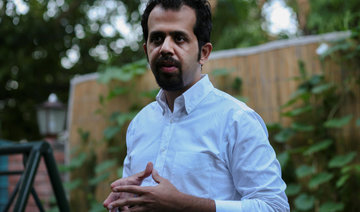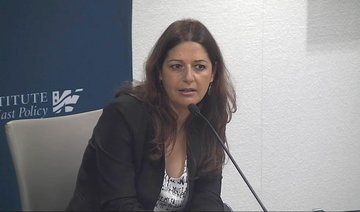BRATISLAVA, Slovakia: Murdered Slovak journalist Jan Kuciak was about to publish an investigation alleging high-level political corruption linked to the Italian mafia, the news portal he worked for revealed Wednesday, as the killing stoked concerns about graft and press freedom in the small EU state.
The weekend killing of Kuciak and his fiancee has sent shockwaves through Slovakia and drawn international condemnation, with organizations including the EU and UN calling for a swift and thorough investigation.
Kuciak, 27, reported for the aktuality.sk news portal owned by German-Swiss Axel Springer and Ringier media group and focused on fraud cases involving businessmen with links to Prime Minister Robert Fico’s governing SMER-SD party and other politicians.
At the stroke of midnight, aktuality.sk and several other news sites published Kuciak’s last, unfinished investigative report on possible political links to Italian businessmen with alleged ties to Calabria’s notorious ‘Ndrangheta mafia supposedly operating in eastern Slovakia.
“Two people from the circles of a man who came to Slovakia as someone accused in a mafia case in Italy have daily access to the country’s (Slovakia’s) prime minister,” Kuciak wrote in the article titled “Italian mafia in Slovakia. Its goblins extend into politics.”
“Italians with ties to the mafia have found a second home in Slovakia. They started doing business, receiving subsidies, drawing EU funds, but especially building relationships with influential people in politics — even in the government office of the Slovak Republic,” Kuciak added.
“They owned or still own dozens of companies. Their property is worth tens of millions of euros,” he wrote.
Slovakia’s leading SME broadsheet daily had first revealed the details of Kuciak’s investigation on Tuesday morning.
The SME report triggered a stern rebuke from Fico, who showed reporters stacks of euro bills totaling the one million euro ($1.2 million) reward he has offered for information that could lead to the killers.
“Do not link innocent people without any evidence to a double homicide. It’s crossing the line. It’s no longer funny,” he warned journalists.
Police found Kuciak and Martina Kusnirova shot dead on Sunday at his home in Velka Maca, a town to the east of Bratislava.
He died from a gunshot wound to the chest while his partner was shot in the head, according to police who also reportedly found ammunition arranged around the bodies with the Pravda daily describing the scene as a “warning.”
The shooting followed the October murder of campaigning Maltese journalist Daphne Caruana Galizia — who exposed crime and corruption on the Mediterranean island — in a car bombing.
Candlelit vigils have been held for the couple, and there are calls for fresh anti-corruption protests in Slovakia after a wave of demonstrations last year.
Police commander Tibor Gaspar, who has said the the motive was “most likely” related to Kuciak’s investigative journalism, warned reporters that publishing details of the case could tip off suspects.
“How can we do our work effectively if you are alerting some people who may be involved?”
Tom Nicholson, a British-born investigative journalist who worked closely with Kuciak wrote that “the (Slovak) secret service already has the gangsters’ names; both Jan and I were operating from leaked intelligence documents” in an article for Politico.
“Slovak organized crime has never killed reporters, even in the bad old days. Whereas Italy’s mafia gangs have shown no such compunctions,” Nicholson said.
Political analyst Grigorij Meseznikov said the murder and its possible links to the Slovak political elite “could prompt a political earthquake.”
“A red line has been crossed. This case could shake the electorate of the governing SMER-SD party to its foundations.”
Fico is known for his sharp criticism of the media, once telling journalists in 2016 they were “dirty, anti-Slovak prostitutes.”
But he met the editors of top media outlets on Tuesday, saying he wanted to assure them “that the protection of freedom of speech and the safety of journalists is our common priority and that it is extremely important to my government.”
Arpad Soltesz, a journalist with TV JOJ and a former colleague of Kuciak, said the slain reporter had been writing about tax fraud at the “highest levels of Slovak politics.”
“To murder a journalist for their work, that is maybe possible in the Balkans, maybe in the Middle East, it definitely happens in Russia, but not in the European Union,” he said.
“There is only one answer to this kind of act — to finish his work.”
Last year, thousands of mostly young Slovaks joined anti-corruption protests demanding the dismissal of senior government and police officials for alleged foot-dragging on fighting graft.
Transparency International ranks Slovakia as the seventh most corrupt EU member.
Murdered Slovak journalist ‘was probing Italian mafia links’
Murdered Slovak journalist ‘was probing Italian mafia links’

To infinity and beyond: Grendizer’s 50 years of inspiring Arabs

- 50 years after its creation, the Grendizer anime series continues to capture Arab imagination
- Arab News Japan speaks to creator Go Nagai, Middle Eastern fans and retells the story behind the UFO Robot tasked with protecting our planet
LONDON: Few cultural imports have crossed borders as unexpectedly, or as powerfully, as Grendizer, the Japanese giant robot that half a century ago became a childhood hero across the Arab world, nowhere more so than in Saudi Arabia.
Created in Japan in the mid-1970s by manga artist Go Nagai, Grendizer was part of the “mecha” tradition of giant robots. The genre was shaped by Japan’s experience during the Second World War, and explored themes of invasion, resistance and loss through the medium of science fiction.
But while the series enjoyed moderate success in Japan, its true legacy was established thousands of kilometers away in the Middle East.

The anime “UFO Robot Grendizer” arrived on television in the region in 1979, dubbed into Arabic and initially broadcast in Lebanon during the Lebanese civil war. The story it told of the heroic Duke Fleed, a displaced prince whose planet had been destroyed by alien invaders, struck a chord with children growing up amid regional conflict and occupation by Israel.
Its themes of defending one’s homeland, standing up to aggression and protecting the innocent were painfully relevant in the region, transforming the series from mere entertainment into a kind of emotional refuge.
Much of the show’s impact came from its successful Arabization. The powerful Arabic dubbing and emotionally charged voice-acting, especially by Lebanese actor Jihad El-Atrash as Duke Fleed, lent the show a moral gravity unmatched by other cartoons of the era.

The theme song for the series, performed by Sami Clark, became an anthem that the Lebanese singer continued to perform at concerts and festivals right up until his death in 2022.
By the early 1980s, “Grendizer” had spread across the Middle East, inspiring fandoms in Saudi Arabia, Kuwait, Iraq and beyond. For many, it was not only their first exposure to anime, it also delivered lessons on values such as justice and honor.
Grendizer was so influential in the region that it became the subject of scholarly research, which in addition to recognizing the ways in which the plight of the show’s characters resonated with the audience in the Middle East, also linked the show’s popularity to generational memories of displacement, particularly the Palestinian Nakba.

Half a century later, “Grendizer” remains culturally alive and relevant in the region. In Saudi Arabia, which embraced the original version of the show wholeheartedly, Manga Productions is now introducing a new generation of fans to a modernized version of the character, through a video game, The Feast of The Wolves, which is available in Arabic and eight other languages on platforms including PlayStation, Xbox and Nintendo Switch, and a new Arabic-language anime series, “Grendizer U,” which was broadcast last year.
Fifty years after the debut of the show, “Grendizer” is back — although to a generation of fans of the original series, their shelves still full of merchandise and memorabilia, it never really went away.















